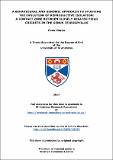Files in this item
A behavioural and genomic approach to studying the evolution of reproductive isolation : a contact zone between closely related field crickets in the genus Teleogryllus
Item metadata
| dc.contributor.advisor | Bailey, Nathan William | |
| dc.contributor.author | Moran, Peter | |
| dc.coverage.spatial | xi, 252 p. | en_US |
| dc.date.accessioned | 2017-02-09T14:20:37Z | |
| dc.date.available | 2017-02-09T14:20:37Z | |
| dc.date.issued | 2017-06-21 | |
| dc.identifier.uri | https://hdl.handle.net/10023/10260 | |
| dc.description.abstract | What processes contribute to the evolution of reproductive isolation and the coexistence of interfertile species in the same habitat? This thesis investigates the relative roles of species interactions and intraspecific processes in contributing to reproductive isolation. I combine behavioural and genomic approaches to test hypotheses about what mechanisms maintain the general species boundary between two closely related field cricket species: Teleogryllus oceanicus and T. commodus. These species are a classic study system for sexual communication and readily hybridize in the laboratory, however little is known about species interactions in sympatric populations. I examine patterns of geographic variation in two key sexual traits: calling song and cuticular hydrocarbons (CHCs), and the geographic distribution of genetic variation across a broad sample of allopatric and sympatric populations. I test whether X chromosomes play a pronounced role in population divergence and reproductive isolation. Using close range mating trials and hybridization experiments I identify numerous pre-mating and post-mating barriers between the species. The results indicate that the species are currently reproductively isolated and the pattern of population differentiation does not strongly support contemporary species interactions contributing to phenotypic diversity. Numerous barriers exist between the species, in particular hybrid females are sterile in both cross directions, while hybrid males are relatively fertile. This provides a rare exception to Haldane’s rule which is central to many genetic theories of speciation. Established theory predicts that X chromosomes should play a pronounced role in the evolution of both pre- and postzygotic barriers. Contrary to this, I found no evidence that X chromosomes contribute to hybrid female sterility. Moreover, X-linked loci exhibited an unexpected pattern of reduced population differentiation within species, but increased species divergence compared to autosomal loci, which may indicate selective sweeps or sex-biased processes. Taken together, the results suggest that the causes and consequences of X chromosome evolution, in particular among XO taxa, may contradict some of the established theories. | en_US |
| dc.language.iso | en | en_US |
| dc.publisher | University of St Andrews | en |
| dc.rights | Attribution-NonCommercial-NoDerivatives 4.0 International | * |
| dc.rights.uri | http://creativecommons.org/licenses/by-nc-nd/4.0/ | * |
| dc.subject | Sexual selection | en_US |
| dc.subject | Reproductive isolation | en_US |
| dc.subject | Speciation | en_US |
| dc.subject | Sex chromosomes | en_US |
| dc.subject | Cuticular hydrocarbons | en_US |
| dc.subject | Mating signals | en_US |
| dc.subject.lcc | QH380.M7 | |
| dc.subject.lcsh | Isolating mechanisms | en |
| dc.subject.lcsh | Sexual selection | en |
| dc.subject.lcsh | Sex chromosomes | en |
| dc.subject.lcsh | Teleogryllus | en |
| dc.title | A behavioural and genomic approach to studying the evolution of reproductive isolation : a contact zone between closely related field crickets in the genus Teleogryllus | en_US |
| dc.type | Thesis | en_US |
| dc.contributor.sponsor | Natural Environment Research Council (NERC) | en_US |
| dc.contributor.sponsor | Orthopterists' Society | en_US |
| dc.type.qualificationlevel | Doctoral | en_US |
| dc.type.qualificationname | PhD Doctor of Philosophy | en_US |
| dc.publisher.institution | The University of St Andrews | en_US |
The following licence files are associated with this item:
This item appears in the following Collection(s)
Except where otherwise noted within the work, this item's licence for re-use is described as Attribution-NonCommercial-NoDerivatives 4.0 International
Items in the St Andrews Research Repository are protected by copyright, with all rights reserved, unless otherwise indicated.


